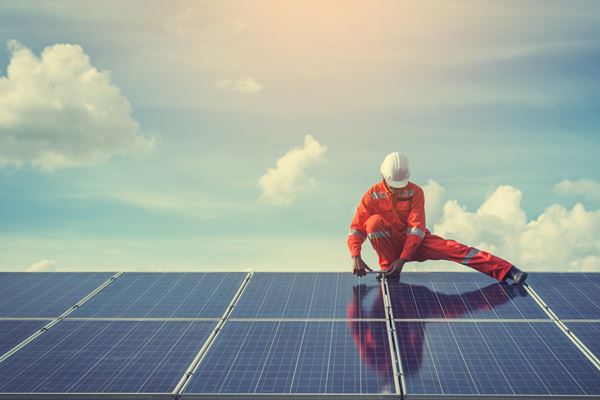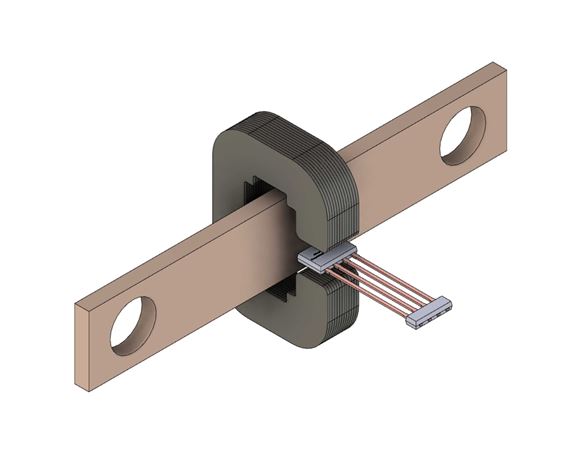Facilitating a Clean Energy Future with Current Sensing Solutions
The climate crisis is a global problem requiring a global solution. The shift to clean energy is not just about saving the planet; it's about creating a sustainable future for everyone. Burning fossil fuels for energy has been the primary driver of global warming, leading to extreme weather events, rising sea levels, and a loss of critical biodiversity. Our reliance on non-renewable fuel sources, such as hydrocarbons and coal, is unsustainable.
Clean energy technologies, like solar, EV batteries, wind, and hydroelectric, offer a sustainable way to meet energy needs without releasing toxic greenhouse gases into the atmosphere, accelerating climate change.
The International Energy Agency (IEA) predicts that a clean energy transition could raise global CO2 capture capacity from around 45 Mt CO2 per year today to over 220 Mt CO2 per year by 2030.
The Energy Dilemma: An Unsustainable Status Quo
The world's energy systems are currently dominated by fossil fuels, which are not only finite but contribute significantly to global warming and environmental degradation. Burning these fuels releases large amounts of greenhouse gases, primarily carbon dioxide (CO2), into the atmosphere, accelerating climate change. Fossil fuel extraction and use have significant social and environmental impacts, such as air and water pollution, land degradation, and health problems. These issues disproportionately affect marginalized communities around the world and worsen socioeconomic inequality.
The Solution: Clean Energy Systems
Renewable energy is widely distributed and virtually inexhaustible. Harnessing these systems to reduce dependence on imported fuels offers a wide range of benefits for energy security. Clean energy systems produce little to no greenhouse emissions, helping mitigate climate change. These systems also reduce air and water pollution, resulting in healthier ecosystems and improved public health for rural and urban populations.
Renewable energy technologies, particularly off-grid and mini-grid solutions, can provide access to electricity in remote areas of developing economies, improving living standards and economic development. Regarding economic prospects, this energy sector is also set to drive job creation and economic growth. Investments in renewable energy technologies, energy efficiency, and grid infrastructure would stimulate economic activity and create jobs in manufacturing, installation, maintenance, and other related sectors.

Where We Are: The Clean Energy Transition
The transition to clean energy is not without its challenges. Significant issues include substantial upfront investment, the intermittency of renewable energy sources, the need for additional grid infrastructure, and insufficient energy storage. Despite the challenges, the benefits far outweigh the costs, making it a crucial component of a sustainable future.
According to a World Energy Investment 2023 report by the International Energy Agency (IEA), investments in clean energy have been on an upward trajectory since 2021. These investments in technology and infrastructure are crucial for meeting the world's announced climate pledges.
The report also highlights that clean energy investment is starting to flow, but it needs to be distributed evenly across countries or sectors. More than 90% of the increase in clean energy investment since 2021 has taken place in advanced economies and China. In many countries, higher interest rates, unclear policy frameworks, and a high cost of capital are holding back investments. However, there are bright spots elsewhere, like the dynamic solar investment in India through government incentives to boost domestic investments and steady renewable deployments in Brazil.
Current Sensors: Enhancing Clean Energy Applications
Innovative technologies like current sensors will be crucial in transitioning to carbon-neutral energy. Current sensing is a technique in electrical systems used to measure or monitor the current flow in a circuit. Current sensors are designed to meet clean energy systems' performance and reliability standards, empowering engineers and providers to deliver safe, reliable, efficient, and affordable solutions.
What Are Current Sensors, and How Do They Work?
Current sensors are electronic components that detect and convert current to a voltage that can be measured easily. They work by detecting and measuring the magnetic field generated by an electric current. Then they convert the magnetic field into an electrical signal proportional to the current. In clean energy applications, current sensors help control the power flow, detect faults, and improve the system’s performance. There are various current sensors, such as Hall-effect sensors and current transformers, each with its own advantages, limitations, and optimal use cases. Let’s look at the three main types of current sensors.
Hall-effect current sensors: These are the most widely used type. They work based on the Hall effect, a phenomenon in which a voltage difference is created across an electrical conductor, transverse to an electric current in the conductor, and a magnetic field perpendicular to the current. These sensors offer the benefit of excellent isolation because they do not require direct metallic contact with the primary circuit. They also measure AC and DC currents and provide good accuracy.

Current transformers: Current transformers (CTs) are used primarily to measure alternating current and work on the principle of magnetic induction. The conductor carrying the current to be measured is used as the transformer's primary. The sensor works as the secondary.
When an AC flows through the primary winding, it produces a changing magnetic field around the conductor, inducing a current in the secondary winding.
Rogowski coils: Used to measure alternating current, a Rogowski coil is a toroidal coil, which is shaped like a doughnut with its conductor wound evenly around its core. The current to be measured is directed through the hole in the center of the coil. Rogowski coils can measure very high currents and detect rapid current changes. However, they require an integration circuit, which adds complexity.
Current Sensor Integration Challenges in Clean Energy Systems
Current sensors play an essential role by monitoring and managing the flow of electrical power in clean energy systems, such as solar panels, wind turbines, energy storage devices, and EVs. Despite this role, their widespread integration and optimal use are hindered by technological, financial, operational, and environmental obstacles.
Let’s explore the specific challenges of integrating current sensors into clean energy applications.
Efficiency
Efficiency is critical in clean energy applications. Current sensors play a vital role in maximizing efficiency by accurately monitoring and controlling power flow in the system. However, achieving high efficiency requires precise and reliable current sensing, which can be challenging because of temperature variations, electromagnetic interference, and system noise.
Cost Constraints
High-quality current sensors often come with substantial upfront costs. When these costs are scaled up to the level of a large solar farm or wind turbine array, they pose a major barrier to widespread adoption.
Rapid Product Cycles
The rapidly evolving clean energy market demands swift innovation and product development. Current sensor manufacturers must keep up with this pace, which can be challenging, given the complex nature of sensor design and manufacturing.
User Safety
Safety is another critical concern in power systems. Current sensors must ensure user safety by preventing overcurrent conditions that could lead to system damage or fire breakouts. However, designing sensors that can reliably detect and respond to such conditions is a complex task.
Design Complexity
Simplifying sensor design can lower manufacturing costs and increase reliability. However, achieving this without compromising performance is difficult. Current sensors should also be easy to integrate into power systems and straightforward to use, requiring careful design and easy-to-use interfaces.
Key Considerations in Choosing Current Sensors
Current sensors play an essential role in maintaining system reliability, optimizing performance, and ensuring the safety of clean energy applications. Below are some important parameters to consider when selecting them.
Accuracy and Sensitivity
Current sensors must accurately measure the current levels in a system because this is essential for optimizing energy usage and preventing overcurrent conditions. Sensitivity refers to the sensor's ability to detect small changes in the current. High sensitivity is desirable because it enables precise control of power systems.
Bandwidth and Response Time
The bandwidth of a current sensor refers to the range of frequencies it can accurately measure. High bandwidth allows the sensor to accurately measure current in systems with a wide range of operating frequencies. The response time measures the time it takes for the sensor to respond to a change in the current. A faster response time allows the sensor to quickly detect and react to overcurrent conditions, enhancing the safety and efficiency of the power system.
Isolation
Isolation refers to the ability of the current sensor to operate without a physical connection to the power system. This is important for safety reasons because it prevents electrical faults in the power system from affecting the sensor.
Environment
Clean energy systems often operate in harsh environments (extreme cold and heat) that can affect the longevity and reliability of electronic components. For instance, solar installations are exposed to extreme temperatures and weather conditions, which can impact the performance of current sensors. Choosing sensors that are robust, durable, and able to operate in a wide range of temperatures and conditions is crucial.
Allegro MicroSystems: Driving the Clean Energy Transition
With the clean energy market poised for rapid growth, the demand for efficient, reliable, and accurate electronic components, such as current sensors, will increase. More than $1.7 trillion will be invested in clean energy systems in 2023, according to an IEA report.
Allegro MicroSystems is at the forefront of semiconductor solutions for the clean energy industry, offering high-performance and cost-effective current sensors designed to meet the requirements of a broad range of clean energy applications. With decades of experience, Allegro has earned a reputation for excellence and reliability in diverse markets. Allegro’s current sensor solutions offer a wide range of working voltages for ultralow power losses, increased reliability, and ease of integration in clean energy systems. The solutions’ small footprint and lightweight construction help to optimize PCB space and the bill of materials, improving overall cost and efficiency.
With a robust and growing current sensor portfolio, Allegro lets engineers and manufacturers deliver safe, reliable, efficient, and affordable systems to market faster by providing sensing and power IC technology solutions to enhance power conversion, support high-speed systems, and reduce energy loss and thermal dissipation.
Based on the article, "Facilitating a Clean Energy Future with Current Sensing Solutions" by Zach Nelson, originally published in EE Power, July 26, 2023. Republished with permission. For portions not copyrighted by original publisher, Copyright ©2023, Allegro MicroSystems, Inc.
Copyright 2023, Allegro MicroSystems.
The information contained in this document does not constitute any representation, warranty, assurance, guaranty, or inducement by Allegro to the customer with respect to the subject matter of this document. The information being provided does not guarantee that a process based on this information will be reliable, or that Allegro has explored all of the possible failure modes. It is the customer's responsibility to do sufficient qualification testing of the final product to ensure that it is reliable and meets all design requirements.
Copies of this document are considered uncontrolled documents.
